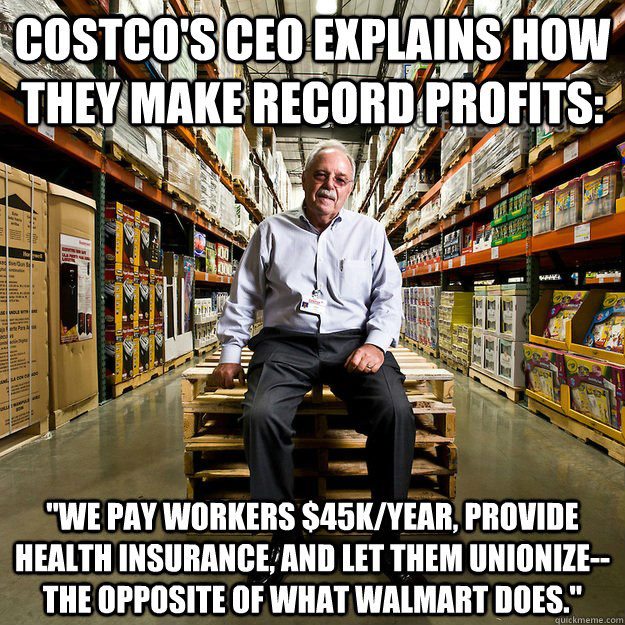 Here’s a reason to renew your Costco membership: not only does the company pay its average worker $45,000 per year, it has also resisted pressure from Wall Street to cut wages and benefits since going public in 1985.
Here’s a reason to renew your Costco membership: not only does the company pay its average worker $45,000 per year, it has also resisted pressure from Wall Street to cut wages and benefits since going public in 1985.
That anecdote came out in a BusinessWeek interview with Costco CEO Craig Jelinek, who said that instead of bowing to pressure and reducing wages and benefits, it has bumped them up every three years.
While 50 cents an hour won’t make anyone rich, it’s more than $1,000/year for a full time employee – and a critical way to keep people and families from falling out of the quickly shrinking middle class. It also shows Costco’s willingness to buck the big business trend of punishing employees when the going gets tough by treating workers not as cogs in the machine, but as valued employees.
Most telling is a quote from Costco CFO Richard Galanti, who said:
Could Costco make more money if the average wage was two or three dollars lower?” asks Galanti. “The answer is yes. But we’re not going to do it.”
This isn’t the first time Costco has been in the news for its good treatment of employees. In July 2005, The New York Times profiled the company, calling it the “Anti-Wal-Mart”. In that piece, the author writes that some Wall Street analysts are critical of the company because it is “overly generous not only to Costco’s customers but to its workers as well.” Likewise, the Seattle PI outlined its employee benefits in a 2004 article, saying that while only a fraction (13%) of its workforce is unionized, nearly all employees enjoy a good deal of benefits ranging from high wages to health care.
Costco – a local company – is a prime example of the kind of business model that not only leads to tremendous profit but a strong economy. For the fiscal year ending in August 2012, for example, Costco reported a $1.7 billion net profit.
But in today’s world of cutthroat capitalism, with the aforementioned pressures placed on businesses from Wall Street, many businesses have not taken Costco’s route, instead choosing to slash wages and benefits. This means more people – even some working full time – are forced onto public assistance for health care and food. Essentially, corporations like Wal-Mart that pay low wages and offer meager benefits (or none at all), are forcing their employees onto public assistance. This pencils out to massive public subsidies for multi-billion dollar corporations.
In order to rebuild the middle class, we can’t wring our hands and hope altruistic business executives simply decide to pay higher wages and benefits. Most corporations – bowing to Wall Street pressure – have gone in the opposite direction. Instead, we need to support the right of workers to organize and bargain for fair wages and benefits, because no one working full-time should have to live in poverty.
We also have a duty as consumers to vote with our wallets; we should choose to spend money in places where workers are valued, respected, and fairly compensated. Otherwise, corporate executives will continue to garnish the paychecks of workers while simultaneously vilifying them for needing government assistance.
By EOI Intern Bill Dow
More To Read
January 17, 2025
A look into the Department of Revenue’s Wealth Tax Study
A wealth tax can be reasonably and effectively implemented in Washington state
January 13, 2025
Meeting the Moment: EOI’s 2025 Legislative Agenda
This session, lawmakers must pass multiple progressive revenue solutions to fund the programs and services that help make Washington communities affordable
January 6, 2025
Initiative Measure 1 offers proven policies to fix Burien’s flawed minimum wage law
The city's current minimum wage ordinance gives with one hand while taking back with the other — but Initiative Measure 1 would fix that
